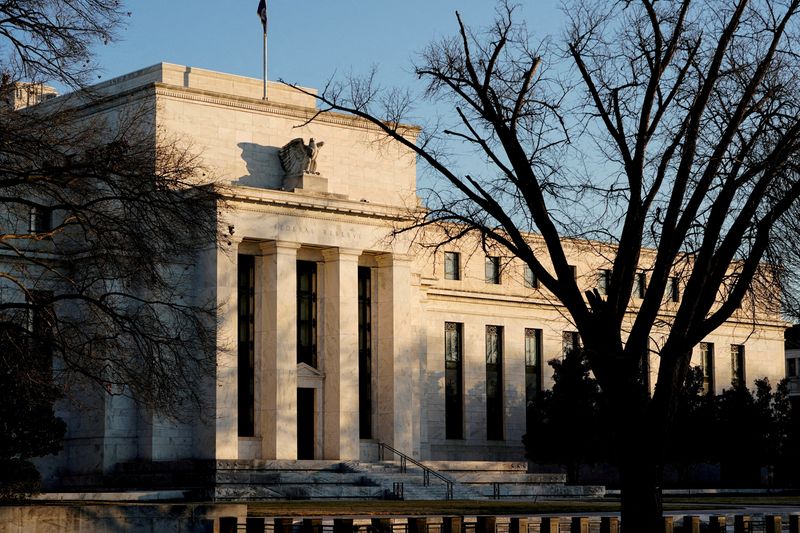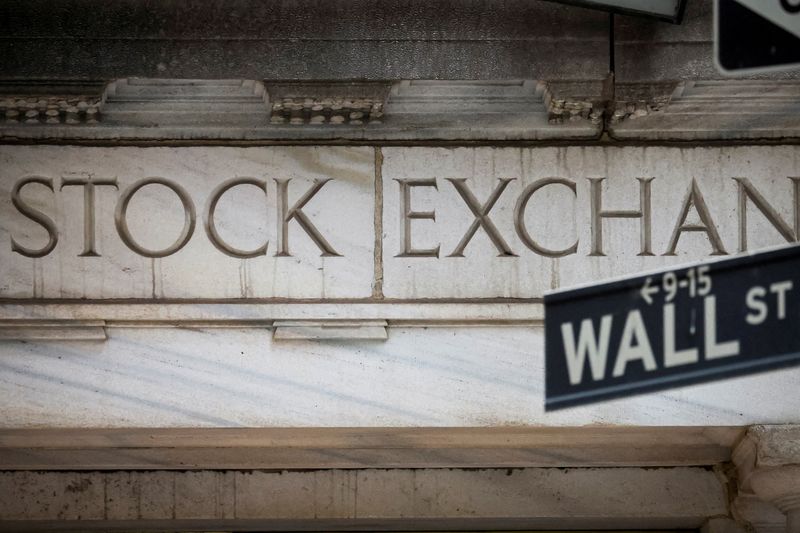By David Randall, Saqib Iqbal Ahmed and Lewis Krauskopf
NEW YORK (Reuters) – Investors wondering whether markets can continue their torrid rally are eyeing one important factor that could boost assets: a nearly $6 trillion pile of cash on the sidelines.
Soaring yields have pulled cash into money markets and other short-term instruments, as many investors chose to collect income in the ultra-safe vehicles while they awaited the outcome of the Federal Reserve’s battle against surging inflation. Total money market fund assets hit a record $5.9 trillion on Dec. 6, according to data from the Investment Company Institute.
The Fed’s unexpected dovish pivot on Wednesday may have upended that calculus: If borrowing costs fall in 2024, yields will likely drop alongside them. That could push some investors to deploy cash into stocks and other risky investments, while others rush to lock in yields in longer-term bonds.
Cash has returned an average of 4.5% in the year following the last rate hike of a cycle by the Fed, while U.S. equities have jumped 24.3% and investment grade debt by 13.6%, according to BlackRock data going back to 1995.
“We are getting calls … from clients who have a significant level of cash and are realizing they need to do something with it,” said Charles Lemonides, portfolio manager of hedge fund ValueWorks LLC. “This is the beginning of a cycle that will start to feed on itself.”
Recent market action shows the scramble to recalibrate portfolios may have already kicked off. Benchmark 10-year Treasury yields, which move inversely to bond prices, have fallen around 24 basis points since Wednesday’s Fed meeting to 3.9153%, the lowest since late July.
The S&P 500 is up 1.6% since Wednesday’s Fed decision and stands less than 2% below a record high. The index is up nearly 23% this year.
“If you think the Fed is done with the hiking cycle, then it’s time to deploy cash as the opportunity is there,” said Flavio Carpenzano, fixed-income investment director at Capital Group.
Not all the cash in money market funds may be available as “dry powder” to be invested in stocks and bonds. Some of it is held by institutions that might otherwise have that money in bank deposits and is needed for cash purposes, said Peter Crane, president of Crane Data, which tracks money market funds.
History also shows that the bulk of cash in money markets tends to remain even as rates come down, said Adam Turnquist, chief technical strategist for LPL Financial.
“I think you could start to see some flows come out of money markets and chase this rally, but I don’t think we are going to see anything to the tune of a trillion dollars or some massive flows that some people might expect,” Turnquist said.
And while money market assets are at record highs, their size relative to the S&P 500 is smaller than it has been during past peaks.
Total money market fund assets as a percentage of market capitalization stand at about 15.5%, in line with the long-term median and well below the record high of 64% hit in 2009 in the aftermath of the global financial crisis.
For now, however, investors’ appetite for risk has been easy to spot. In the options market, for example, traders are spurning protection from a near-term drop in stocks even though the price of such hedges is attractive from a historical standpoint. The Cboe Volatility Index, which reflects demand for insurance against market swings, fell to pre-pandemic lows this month.
“No one is interested in buying insurance,” said Chris Murphy, co-head of derivative strategy at Susquehanna Financial Group, noting that the low level of defensive positioning leaves the market vulnerable to a sharp reversal in the event of an unforeseen negative shock.
Indeed, the sharp rebound in equities from their October lows has made some investors wary that markets have risen too quickly.
“There’s enough money out there that it doesn’t take a lot to directionally move the markets higher,” said Jason Draho, head of asset allocation, Americas, at UBS Global Wealth Management.
Still, the swift gains over the past six weeks in both equities and stocks “makes you a little concerned about where the upside is from here for the markets overall,” he said.
(Reporting by David Randall, Saqib Iqbal Ahmed and Lewis Krauskopf; Additional reporting by Dhara Ranasinghe; Editing by Ira Iosebashvili and Leslie Adler)

